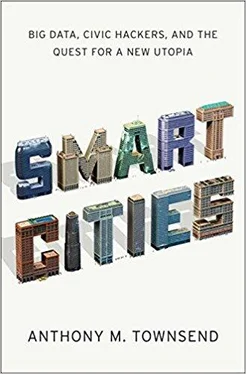But beyond just keeping the lights on, the smart grid could finally unleash the kind of innovation in energy services that we’ve become accustomed to in telecommunications. Start-up firms could audit and manage our home’s electricity use in return for a small cut of the savings off our energy bill. In a world where Siemens forecasts that electricity prices could change as often as every fifteen minutes, we’ll be relieved to have a piece of tracking software automate the process.
By allowing us to account for all of the power we put in and take out of the system, the smart grid will also allow us to add a social layer to the production, distribution, and consumption of electricity. Imagine connecting your smart meter to Facebook. You might dare your neighbors to cut back as much as you do, in a game to save the earth played out on the smart grid of your neighborhood. Or, as Eric Paulos of the University of California, Berkeley, proposes, we can decommodify energy by creating sensors to document how, where, and by whom it was generated and making this information available during transactions. “Is it fresh energy? Is it local energy?” he asks. What if instead of sending a text message, a child could send mommy the 100 watts she just produced on a power-scavenging swing set? Scale this model up, and it is possible to imagine a rich trade of power between many producers and consumers, incentivized by any number of causes, interests, or goals. A social meta-layer on the smart power grid could have enormous impact on our consumption choices.
Deregulation now allows many consumers to choose which producer to buy their electricity from, even as that power is still delivered across a single grid controlled by the local utility. Power providers compete on price and carbon footprint. But we are moving into a world where the data about electricity will become as valuable as the power itself. Already, start-ups like Arlington, Virginia-based Opower are showing how smart meters will enable utilities to bundle information and services with basic electricity to add value. These tools can help consumers save money, and are very convenient. They also hold the potential to make us more understanding and conscientious about how we use electricity. Choosing your power provider in the age of the smart grid will be more like choosing a mobile phone carrier is today. The grid itself is a commodity. All the value is in the add-ons.
The Fourth Utility
The power grid is the circulatory system that delivers the lifeblood of electricity throughout cities. Data networks are their nervous systems, shuttling messages to and fro. Much as we are upgrading the power grid, new communications networks are upgrades to systems first built during the rapid growth of cities in the nineteenth century. In fact, the first urban digital communications network was the telegraph. The dots and dashes of Morse code were as binary as the Os and Is of the digital computer.
The telegraph didn’t appear out of nowhere. It was invented specifically to meet the growing need to coordinate vast commercial and government enterprises. By the mid-1800s, the industrial revolution was hitting full stride. Steam-powered machines allowed businesses to make and transport goods on such a massive and rapid scale that human managers couldn’t keep up. It was a full-fledged “crisis of control,” as sociologist James Beniger described it. “Never before had the processing of material flows threatened to exceed, in both volume and speed, the capacity of technology to contain them.” Throughout the first half of the 1800s, tinkerers in Europe and the United States worked feverishly to develop systems for transmitting messages via wire using electrical pulses. The race culminated in the 1840 patent for the Morse-Vail system. Telegraph systems fueled the expansion of intercity trade by synchronizing railroad operations. For the first time, business information could move faster than the speed of travel.
Much like todays new communications technologies, the telegraph inspired its own set of urban visions. In the 1850s, just as Siemens was stringing telegraph lines between German cities, the Spanish city of Barcelona broke free from the shackles of history and began to expand and modernize. Hemmed in for centuries by its city wall, rapid industrialization had turned the city into one of Europe’s most densely populated. In 1854, authorized by royal decree, citizens eagerly began tearing the wall down by hand. As one historian recounted the riotous affair:
As soon as the news of the government’s long-desired permission to pull down the wall was known, there was a general rejoicing in the city, and its shops were emptied of pickaxes and crowbars overnight. Almost every citizen rushed to the wall to participate in its demolition, either by using the appropriate tools or by supporting orally those who were actually doing the work. The wall was, probably, the most hated construction of that time in a European city....It took twelve years to pull them down, which is not a long time when we remember that they had stood erect for nearly one and a half centuries.
The way was clear for the city to modernize and grow by exploiting the new technologies of the “control revolution,” as Beniger dubbed this great period of technological and organizational transformation.
Outside the walls lay a blank canvas of sparsely settled countryside onto which Ildefons Cerda, a visionary civil engineer, laid out a new district designed around the potential of the railroad and the telegraph. In his 1867 opus Teona General de la Urbanizacion (General Theory of Urbanization), Cerda expressed his fascination with these new technologies, contrasting the “calm and tranquil, almost motionless man of the earlier generations that preceded us” with the “active, daring, entrepreneurial man... who in just minutes transmits and circulates his news, his instructions, his commands right around the globe.”35 His plan for L’Eixample (literally, “the extension”), embraced these new technological capabilities.
Cerda didn’t just dream. His sketches provided precise diagrams for accommodating the telegraph. “It is indispensable for the underground Extension works to include a way to accommodate this service in the most convenient and economic way possible ...,” he wrote, “for this it is only necessary to leave enough room in the ducts for the wires to be laid.”56 His plan called for “four longitudinal conduits for each street: 1) For the distribution of drinking water. 2) For the disposal of sewage. 3) For the distribution of gas. 4) For the laying of telegraph wires.” ' In Cerda’s vision the telegraph would be a fourth utility for the industrial city, a network that author Tom Standage has called “The Victorian Internet.”
Over 150 years later, Cisco Systems has unwittingly commandeered Cerda’s schema as it plans the next generation of telecommunications networks for cities throughout the world. “Visionary countries... understand that the network is the fourth utility,” proclaims the company’s chief globalization officer, Wim Elfrink, “enhancing global competitiveness, innovation and standard of living.”
Today Cisco is becoming a household name, but few people realize the company is an industrial giant on the scale of Chrysler or Dow Chemical, with some $40 billion-plus in annual revenues. Founded in 1984 by husband and wife Len Bosack and Sandy Lerner, who built Stanford University’s campus network in the early 1980s, Cisco has grown into the world’s leading supplier for the sophisticated switches and routers that power the Internet. Cisco’s products not only push bits around offices, schools, and homes, but also sling them back and forth across undersea cables that link continents. It’s one of Silicon Valley’s largest and most-watched bellwethers. For a brief period in March 2000, at the height of the telecom bubble, it was the most valuable company in the world.
Читать дальше












